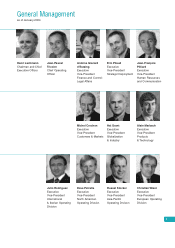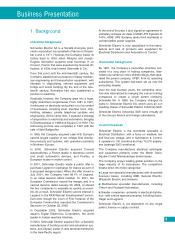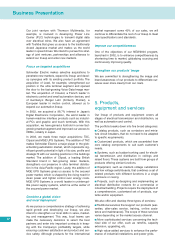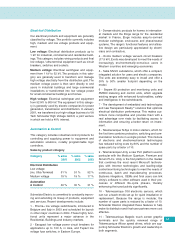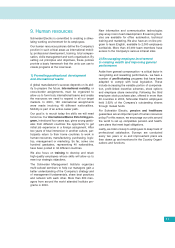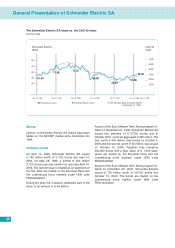APC 2003 Annual Report Download - page 18
Download and view the complete annual report
Please find page 18 of the 2003 APC annual report below. You can navigate through the pages in the report by either clicking on the pages listed below, or by using the keyword search tool below to find specific information within the annual report.
Integrators and contractors
Aside from our work with distributors, we devise solu-
tions for customers in close cooperation with other
partners, including:
■Panelbuilders, OEMs and systems integrators.
■Contractors, ranging from large firms specialized in
installing equipment and systems to small special-
ized and general electricians.
■Specifiers, including design and engineering firms,
consultants and architects, and systems specialists.
Specifiers and consultants
Specifiers and consultants, such as architects and
building designers, represent an indirect customer
base in that they recommend or include functionali-
ties in their specifications that channel demand
towards Schneider Electric products. They are key
partners for us as they define the performance, safe-
ty and comfort requirements of Electrical Distribution
and Automation & Control installations and devise
innovative solutions that help inspire our future prod-
uct development.
Global Strategic Accounts
While distributors are critical to our business, we also
sell directly to a wide range of end users and inter-
national OEMs. Our dedicated Schneider Global
Business Development (SGBD) unit was created to
serve these customers. In 2003, they represented
around 8% of total sales.
Our top SGBD accounts are DaimlerChrysler,
Renault, General Motors, Veolia, Bristol-Myers
Squibb, Nestlé, IBM, Motorola, Caterpillar, Emerson,
Areva, Faurecia, Chevron Texaco, Telefonica, Texas
Instruments and Thyssen Krupp. The number of
accounts has grown steadily, from 20 in 1997 to 85 in
2002 and more than 100 in 2003, and we will contin-
ue to add new customers to the list.
To ensure that each global account receives the
same quality of service around the world, we have
set up an organization in which our subsidiaries and
regional agencies can cooperate to standardize the
design, production and installation of the products,
equipment, projects and services that our customers
need. In addition, each member of our General
Management team oversees one or several global
accounts as part of SGBD. In most cases, the rela-
tionship is formalized in a comprehensive Program
Alliance that sets out agreements concerning prices
and/or services, development and product modifica-
tions. SGBD allows us to meet our global accounts’
needs more effectively, support our worldwide pres-
ence and push the technological envelope with cus-
tomers who expect cutting-edge solutions.
8. Production
Schneider Electric has 177 production sites world-
wide. Of these, 58 are global facilities that manufac-
ture products, equipment and components for our
three operating divisions. The others are generally
located as close as possible to the markets they
serve. Decisions on where to set up local and global
plants are based on criteria such as market proximi-
ty, competitiveness and skills developed over time.
Although most of our products are built from stan-
dardized components so that they can be sold
around the world, they are also adapted to local stan-
dards and requirements. Design and esthetics are
sometimes adapted to local needs, but we focus
heavily on standardizing key components to achieve
scale economies in production. Certain physical fea-
tures will vary from region to region. This global/local
approach helps us optimize profitability.
While we do tailor our products and equipment to
local standards, the majority of our lineup complies
with world-recognized International Electrotechnical
Commission (IEC) standards. In North America, our
products generally meet standards set by the
National Electrical Manufacturers Association
(NEMA), Underwriters Laboratory (UL) or American
National Standards Institute (ANSI). Since our prod-
ucts comply with the dominant standards in our host
markets, we are able to meet most of our customers’
needs.
We use raw materials such as silver, copper, steel,
non-ferrous metals and plastics, as well as electron-
ic components to manufacture our products.
We source from a diversified base of suppliers,
selected for their know-how, their products’ quality
and competitiveness and their compliance with envi-
ronmental and social responsibility requirements.
Our supplier list includes international companies
such as Nippon Steel, DSM and Arcelor, as well as
medium-sized firms like Gindre Duchavany or AMI
Doduco. In 2003, raw material and component pur-
chases totaled € 2.6 billion.
Business Presentation
16



